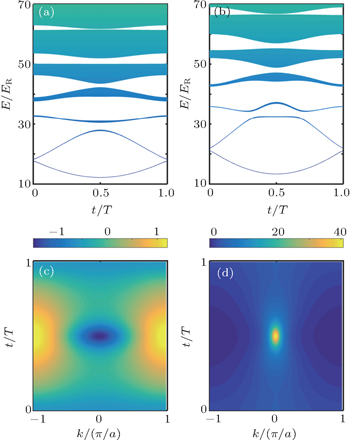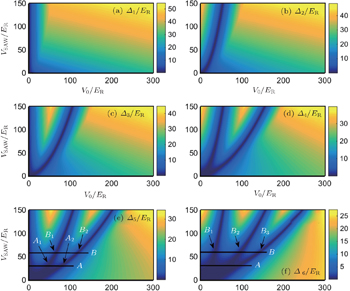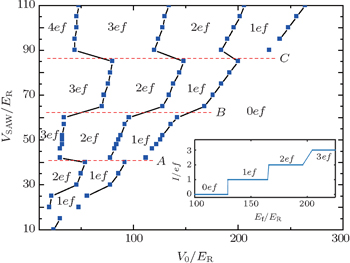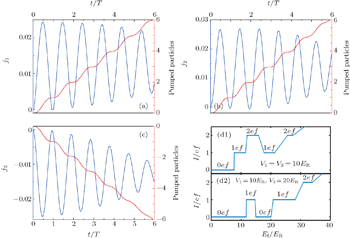† Corresponding author. E-mail:
Project supported by the National Natural Science Foundation of China (Grant No. 11374036) and the National Basic Research Program of China (Grant No. 2012CB821403).
Quantized electron pumping by the surface acoustic wave across barriers created by a sequence of split metal gates is interpreted from the viewpoint of topology. The surface acoustic wave serves as a one-dimensional periodical potential whose energy spectrum possesses the Bloch band structure. The time-dependent phase plays the role of an adiabatic parameter of the Hamiltonian which induces a geometrical phase. The pumping currents are related to the Chern numbers of the filled bands below the Fermi energy. Based on this understanding, we predict a novel effect of quantized but non-monotonous current plateaus simultaneously pumped by two homodromous surface acoustic waves.
The surface acoustic wave (SAW) is frequently used as an experimental tool to transport electrons in one-dimensional (1D) quantum lines as well as in two-dimensional electron gases (2DEGs).[1,2] The SAW experiments in the 1D channel on GaAs-AlxGa1–xAs heterojunctions reveal quantized plateaus of acoustic-electric current which are proportional to the frequency of the acoustic wave, I = n · ef (n is an integer).[3] It means that an integer number of electrons are pumped through the channel in one oscillating cycle of the SAW. A lot of theoretical works have attempted to interpret this quantum phenomenon.[4–7] It is intuitively considered that the Coulomb-blockade effect may play a key role. The explicit mechanism, however, remains controversial. In Ref. [8], the authors discussed the precision of the plateaus and impurity of the potentials. Other works of modeling the quantized pump are based on the tight-binding model which consists of discrete quantum dots and two leads connecting the electron reservoirs on each side. The non-interacting electron transportation is expressed by reduced nearest-neighbor hopping amplitudes.[9,10] This model is analogous to the discrete 1D Harper model which exhibits a non-trivial topological phase.[11]
Topology as a mathematical conception has been serving the condensed matter physics for 30 years since the explanation of the quantized Hall effects. It has become a useful means in understanding the topological insulator,[12] superconductivity,[13–15] and the quantized charge or spin pump.[16,17] It has been implemented in optical lattices[18,19] and in graphene-like materials as well.[20,21] In this paper, we propose a setup with a sequence of split metal gates in the 1D channel, creating a sequence of barrier potentials. We then explore the topology implications of the quantized charge pumping by a SAW within the band theory. In the quantized charge pumping process, the electrons follow an adiabatically varying potential.[22] The surface acoustic wave is taken as a spatially periodical potential whose energy spectrum possesses the Bloch band structure, whereas the time-dependent phase plays the role of an adiabatic parameter of the Hamiltonian which induces a geometrical phase. The staircase-like acoustic currents are characterized by topological Chern numbers. We investigate the dependence of the number of pumped electrons on physical parameters such as the height of the barrier, the amplitude of the SAW and the Fermi levels and reveal a series of topological transitions. Based on this interpretation, we further predict a novel effect of quantized but non-monotonous current plateaus simultaneously pumped by two homodromous SAWs.
The 1D narrow channel was experimentally realized by a split metal gate on the surface of a GaAs-AlxGa1–xAs heterojunction. The time-dependent SAW potential induced by the piezoelectric effects is written as



For the slowly oscillating SAW, the system can be treated as a quasi-static problem. The time-dependent phase δ = ωt is taken as a variable parameter that yields a Berry phase as δ changes to complete a cycle from 0 to π. The Bloch wave vector k is approximately a good quantum number at a given δ. The periodicity both in the k-space and the δ-space defines a 2D Brillouin zone (BZ). In the upper row of Fig.
The Berry curvature of a given band in the torus-shape BZ is defined as


The Chern number of each band can be computed as long as they are well-separated. For example, the integrations of Berry curvature distributions in Figs.
| Table 1. Chern numbers Cn of the six lowest energy bands for various values of V0. The amplitude of the SAW is fixed at VSAW = 30ER. The slashes indicate that the Chern numbers are not well-defined due to closing of the gap. . |
Table
We examine the relation of the band topology with the system parameters. Figure 



On the other hand, topological transitions can also be implemented by adjusting the SAW amplitude VSAW. As VSAW increase from 30ER (Fig.
For the particle pumping, we adopt the adiabatic approximation analysis of the geometric phase[25–27] by considering that the velocity of the acoustic wave is much smaller than the Fermi velocity,[28,29]

It satisfies the time-dependent Schrödinger equation iℏ∂t|ψt⟩ = Ĥ(t)| ψt⟩. We have used the instantaneous eigenstates (the Bloch states) |un⟩ of the Hamiltonian Ĥ(t) and 

The last equivalence is obtained by making use of the relation ⟨un|∂H/∂k|un′⟩ = (En − En′)⟨∂un/∂k|un′⟩. Here insulating states rather than conducting states contribute to the induced current, thus only initially full-filled bands are of concern. The pumping current is the integration of ⟨vn(k)⟩ over the BZ, in which the zeroth-order term vanishes. The total number of particles pumped in an oscillating cycle is

This is exactly the Chern number calculated from formulism (
For example, if the lowest four bands are occupied, there are two transition points A1 and A2 in Fig. 



Based on the above analysis, in Fig.
The performance of SAW in split gates without gate voltage is simply a sliding potential, which gives rise to the standard of particle pumping. An extended research has confirmed the equivalence between topological properties and quantized charge pumping of a continuous Rice–Mele pump.[19] In this section, we study the pumping effect of two sinusoidal SAWs with different spatial period but the same temporal frequency. The two SAWs have the same acoustic velocity. It can be realized by implementing an additional SAW propagating at an angle θ to the direction of the 1D channel. Explicitly, we consider the following SAW potential,

The Chern number of each band can be computed in the same way. For V1 = V3 = 10ER, the Chern numbers of the lowest four bands are Cn = 1, 1, − 1, 1. It is straightforward to calculate the current and pumped number of particles. Figure
Finally, if we keep V1 = 30ER while increasing the second SAW amplitude from V3 = 30ER to V3 = 40ER, we can observe a jump from the I = 3ef plateau to the I = 1ef plateau. In this case, the Chern numbers of the four lowest bands experience a transition from Cn = 1, 1, 1, −1 to Cn = 1, 1, −1, 1.
In summary, we have investigated the SAW pumping effects in a 1D channel with barrier potentials caused by the gate voltage. The quantized pumping of electrons is interpreted in the viewpoint of topological invariants of the filled bands. The jump between two adjacent current plateaus is related to a topological transition. One of the benefits of topological theory is that the quantized plateaus are robust against perturbations as long as the gap keeps finite. Based on our interpretation, we predicted non-monotonous current plateaus pumped by two homodromous SAWs. Our prediction can be readily verified by current experiment techniques.[31,32]
| 1 | |
| 2 | |
| 3 | |
| 4 | |
| 5 | |
| 6 | |
| 7 | |
| 8 | |
| 9 | |
| 10 | |
| 11 | |
| 12 | |
| 13 | |
| 14 | |
| 15 | |
| 16 | |
| 17 | |
| 18 | |
| 19 | |
| 20 | |
| 21 | |
| 22 | |
| 23 | |
| 24 | |
| 25 | |
| 26 | |
| 27 | |
| 28 | |
| 29 | |
| 30 | |
| 31 | |
| 32 |






